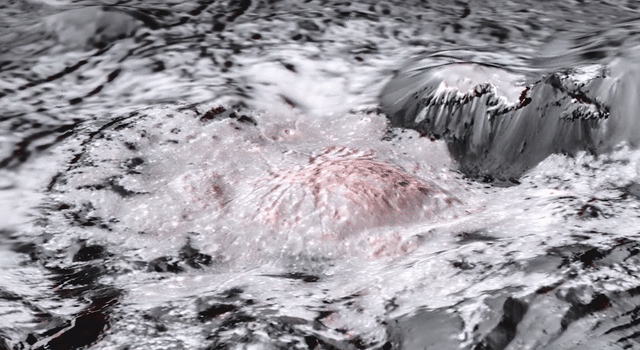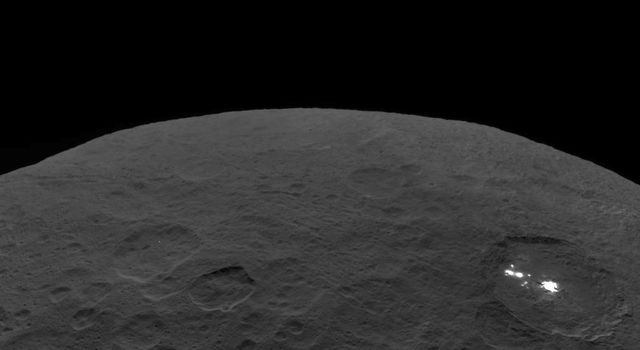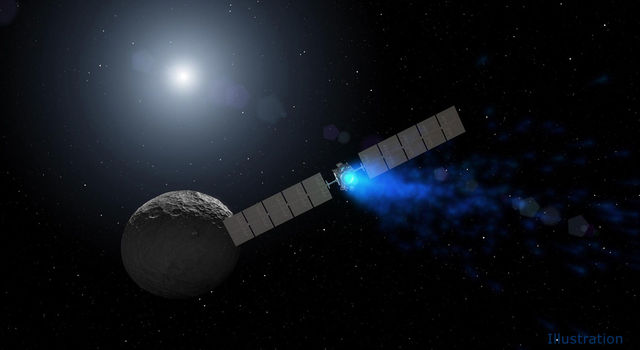Blogs | Dawn Journal | July 27, 2016
Dear Exdawnsions
Humankind dispatched Dawn on an extraordinary extraterrestrial expedition in 2007.
It visited Mars briefly in 2009 and spent 14 months orbiting protoplanet Vesta in 2011-2012, revealing fascinating details of that uncharted, alien world. After traveling for another two and a half years through the interplanetary void, the spacecraft arrived at Ceres in March 2015. It has now conducted an outstandingly successful exploration of the only dwarf planet in the inner solar system. Dawn greatly surpassed its objectives at both Vesta and Ceres, accomplishing well more than was envisioned when NASA decided to undertake this ambitious mission. Having realized its raison d'être, the official end of Dawn's prime mission was June 30.
Following the conclusion of the prime mission, the adventurer began its "extended mission" of performing more Ceres observations without missing a beat. We described in April some of what Dawn can do as it continues investigating many of the mysteries there. Dawn's extension allows for even better measurements with the gamma ray and neutron detector of the nuclear radiation emanating from Ceres. This is like taking a longer exposure of the very faint nuclear glow, yielding a brighter, sharper picture that reveals more about the atomic constituents down to about a yard (meter) underground. The spacecraft is taking more stereo photos, continuing to improve the topographical map it created from four times higher. Scientists also are taking advantage of this opportunity to study more geological features with the visible and infrared mapping spectrometers, providing important insight into Ceres' mineralogical inventory.
Dawn has already made extraordinary discoveries at Ceres, some of which we have described in recent months. But on a dwarf planet of 1.1 million square miles (2.8 million square kilometers), there is a great deal to see. That, after all, is the benefit of being in orbit, lingering long enough to make a richly detailed portrait of the exotic expanse. Indeed, Ceres has 36 percent of the land area of the contiguous United States, or the combined land areas of France, Germany, Italy, Norway, Spain, Sweden and the United Kingdom. In such a vast territory, there are innumerable mysteries to unravel. And that is only the surface.
Dawn also is continuing its studies of the gravitational field to discover more about the interior structure of the largest body between Mars and Jupiter.


In the coming months we will discuss other intriguing activities and how Dawn will make measurements never even considered before. But for now, let's look at how this extension came about.
As readers of the Dawn Journals know (and as you will be reminded below), there has been very good reason in recent years to believe the spacecraft would not operate beyond the end of its prime mission. However, the veteran explorer is in very good health. It is one of Earth's most experienced and capable ambassadors to the cosmos, we want to squeeze as much out of this mission as we can. Ever resourceful, the Dawn team recognized in March 2016 that the probe had the capability to do yet more and decided to give NASA Headquarters a unique choice: remain at Ceres (as always expected) or go elsewhere.
It is worth pondering how extraordinary this is. Most spacecraft can only make minor adjustments to their trajectories, so at the end of their prime missions, they generally go wherever they were already headed. If a spacecraft is in orbit around some planetary body, it remains in orbit. If a spacecraft is not in orbit, having previously flown past one or more bodies that orbit the sun, its course is largely determined by the targeting for the last encounter. A planet's gravity may have redirected it, but otherwise its propulsion system has to do the work, and that usually can produce only a tiny change in direction. If a spacecraft is not already in orbit around a planetary body, it won't be able to enter orbit.
Dawn is different. With its uniquely capable ion propulsion system, Dawn is the only spacecraft ever to travel to a distant destination, orbit it, later break out of orbit, then travel to another faraway destination, and orbit it. And even while in orbit around Vesta and Ceres, Dawn maneuvered extensively, optimizing its orbits for its scientific investigations. And yet this remarkable ship can do still more. It has the capability to leave its second destination and continue its travels.
Dawn's brilliant and creative navigators analyzed possible missions to more than 68,000 known objects. That alone is a nice illustration of the powerful potential.
The project team very quickly narrowed the list to the most interesting body Dawn could reach after leaving Ceres, a large asteroid named Adeona. That mission offered the best alternative to further studies of the dwarf planet.


But how to decide between these two attractive possibilities? Some members of the Dawn team preferred continuing the exploration of Ceres and others preferred going to Adeona. Similarly, some people prefer cake and some prefer pie. (That's not a perfect example, because it's obvious cake is better, but you get the idea.)
NASA thoroughly evaluated the scientific potential and other aspects of the options. Part of this was an assessment by an independent group of esteemed scientists. The conclusion was that either would be valuable but that studying Ceres further was preferable.
From the perspective of your correspondent -- passionate about space exploration since the age of four, a professional scientist (as well as a scientist at heart), an engineer and a taxpayer -- this is a wonderful outcome. How could one want anything other than such a well-considered decision?
But how is it even possible that the team could have offered to NASA the option of visiting Adeona for the extended mission? We have emphasized for several years that Ceres would be Dawn's final home. If you had asked even as recently as early this year whether the spacecraft could leave Ceres (and many of you did), we would have responded that such a prospect was unrealistic and inconceivable (and we did). We have described in great detail how the failure of two of Dawn's four reaction wheels was so serious that it was only with heroic effort that the distant robot was able to complete its original assignments. We have explained repeatedly that the spacecraft will soon expend the last of its hydrazine propellant, then immediately lose the ability to point its solar arrays at the sun, its antenna at Earth, its scientific sensors at Ceres or its ion engine in the direction needed to fly elsewhere. Why the change now, and how could Dawn operate for a multiyear journey?
We have discussed in recent months how remarkably well the flight team has done in conserving hydrazine, significantly exceeding any reasonable expectations and thereby extending Dawn's functional lifetime. Moreover, mission controllers know that the probe consumes less hydrazine at higher altitudes. Contrary to many people's notions, the dwarf planet's gravity is appreciable, and operating so close to it requires a very high rate of hydrazine consumption. Dawn is circling only 240 miles (385 kilometers) above Ceres, closer than the International Space Station is to Earth. But during the long deep-space journey to Adeona, Dawn would use the precious propellant much more sparingly. So despite the loss of the two reaction wheels, under the expert guidance of its terrestrial colleagues, the ship could set sail once again for a new and distant land beyond the horizon.

Isn't it incredibly cool that humankind has the capability to fire up the ion engine on a distant interplanetary spaceship and pilot it out of orbit around a dwarf planet to fly more than halfway around the sun on a bold expedition of 900 million miles (1.5 billion kilometers) to investigate a huge asteroid? (Hint: the answer is yes.)
Exciting as such a voyage might seem, it is gratifying that a thoughtful, rationale decision was made that yields an even better outcome. Rather than terminate the present mission after it has exceeded all of its original objectives, and rather than embark on that new mission, the best possible use of Dawn is to do what it is doing right now: extracting secrets from dwarf planet Ceres. And now we can look forward to more, as Dawn pursues new objectives. As the extended mission progresses, we will describe marvelous new findings from the rich trove of data Dawn is returning, and we will see how the team plans to take advantage of this unique opportunity to learn more about the nature of the solar system.
If you share in the passion for exploration, if you thrill to new discoveries and new knowledge or even if you just want to see how many more silly Dawn Journal greetings your correspondent can concoct, stay onboard as Dawn's adventure at Ceres continues.
Dawn is 240 miles (385 kilometers) from Ceres. It is also 2.69 AU (250 million miles, or 403 million kilometers) from Earth, or 1,090 times as far as the moon and 2.65 times as far as the sun today. Radio signals, traveling at the universal limit of the speed of light, take 45 minutes to make the round trip.
Dr. Marc D. Rayman
4:00 p.m. PDT July 27, 2016







